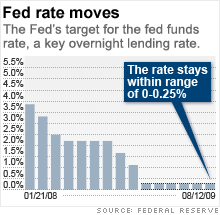
Despite more recovery hopes, the central bank isn't showing signs of backing off efforts to pump more than $1 trillion into the still struggling U.S. economy.
The Federal Reserve clearly isn't rushing for the exits any time soon.Even though the Fed suggested last week that the economy had bottomed out and is poised to start growing again, the central bank has yet to lay out details of its so-called "exit strategy" to unwind all the steps it has taken in the past year to try and get the economy back on track.
In fact, the Fed's latest moves show that there are no immediate plans to stop pumping money into the economy.
On Monday, it extended the Term Asset-Backed Securities Loan Facility, or TALF until June 30 of 2010. That program, which essentially guarantees securities backed by a wide variety of consumer and business loans, was originally set to expire in December.
Last week, Fed policymakers announced they would complete their purchase of $300 billion in long-term Treasurys this fall and also confirmed plans to buy up to $1.25 trillion in mortgage-backed securities by the end of the year.
These and other extraordinary programs come on top of the Fed's decision in December to slash its key overnight lending rate to nearly 0% for the first time in its history.
Some economists worry that if the Fed is too slow to rein in its various liquidity programs, all the cash it has injected into the financial system could spark a jump in inflation.
"The ingredients for runaway inflation down the road remain in place," said Allen Sinai, chief global economist for Decision Economics. "Right now inflation is quiet, but it's a sneaky problem, it's like cancer. It sneaks in and sneaks up and one day the world wakes up and it's there."
Fed Chairman Ben Bernanke has repeatedly said the central bank has the tools it needs to pull back on these programs, but he has yet to say how or when it will do so.
Sinai thinks it's important for the Fed to start providing such details in order to give investors confidence that inflation will not get out of hand.
If the markets start to doubt the Fed's commitment to fighting inflation, investors could sell bonds and drive up long-term Treasury rates in the process. (Bond prices and yields move in opposite directions.) Higher long-term interest rates could negate some of the steps the central bank has taken to spur a recovery through low rates.
"They have nothing to lose by being more explicit about an exit plan," Sinai said. "The view of the inflation risk down the road isn't going to go away until the Fed makes them goes away."
But other experts say that with the economy still so weak, it's even more important to convince businesses that the Fed is committed to doing everything it can to spur stronger demand ahead.
Supporters of Fed policies said it was particularly crucial for the Fed to extend TALF because it is the most effective tool it has to address growing problems in the commercial real estate market. This should limit the risk of new shocks to the still vulnerable banking system.
"There are a lot of challenges ahead in the commercial mortgage market," said Kevin Petrasic, a banking lawyer in the Washington office of Paul Hastings. "The Fed recognizes the reality we're in; things are improving but they're not where we need to be."
In addition, some argue that if the Fed gives hard and fast rules for how it plans to unwind its lending programs, it could make it more difficult to respond to future economic or financial market challenges.
"'The Fed has articulated a broad strategy to explain how it will extricate itself," said Bernard Baumohl, executive director of the Economic Outlook Group. "They can't describe it entirely because it might defeat their goals."
Those who think the Fed won't find itself behind the curve on inflation added that most of the Fed's programs will essentially unwind themselves well before there is any inflation threat.
The Fed programs generally charge borrowers a premium over normal market rates. That should give companies incentives to look elsewhere once the conditions in various financial markets improve.
For example, the Fed announced a program last fall to buy commercial paper, the debt instruments used by major businesses and financial firms to fund their operations, when that market seized up.
In January, near the height of the financial crisis, the Fed held $350 billion in such debt. Now, it holds only $60 billion, and experts believe the balance could be down to nearly zero by the time the program expires next February.
To be sure, the Fed's balance sheet is still fairly bloated. With $2.1 trillion in assets, that is more than double the level of a year ago and down only slightly from the high water mark of $2.3 trillion from last December.
But some economists said it's worth pointing out that the balance sheet shrunk even as the Fed rolled out TALF and its programs to buy mortgage-backed securities and Treasurys. So as long as the Fed isn't pumping additional money into the system, there may not be a significant inflation risk.
"What the Fed is saying is 'Don't expect any more, but we're going to leave what we have in place for a fair amount of time,'" said Keith Hembre, chief economist for First American Fundsmoney.cnn.com
No comments:
Post a Comment